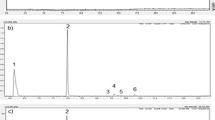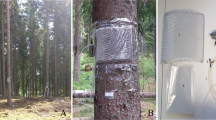Abstract
Volatile compounds in the lipid coating of the lower-back quills of the North American porcupine,Erethizon dorsatum, were collected using headspace trapping on Tenax and analyzed by gas chromatography–mass spectrometry (GC-MS), GC with organoleptic detection, and GC with a chiral stationary phase. Over 50 components were isolated, primarily oxygenated aliphatics, lactones, and isoprenoids. The most abundant constituent was tetradecyl acetate, which does not contribute significantly to the odor of the quill lipids. GC with a wide-bore capillary column and a human nose as detector was used to determine the retention time of the peak with the characteristic porcupine odor. Comparison of this organoleptic chromatogram with those obtained with a flame ionization detector and GC-MS showed the compound to be a δ-decalactone. The racemic mixture of this optically active substance does not possess the unique odor. Resolution of the enantiomers of δ-decalactone by GC with a chiral cyclodextrin phase shows that the isomer possessing the characteristic porcupine odor is the(R)-δ-decalactone. We suggest the biological function of this compound is to serve as a warning odor, which, in conjunction with an initial quill strike, produces a conditioned aversion in potential predators.
Similar content being viewed by others
REFERENCES
ALBONE, E. S., and SHIRLEY, S. G. (eds.). 1984. Mammalian Semiochemistry: The Investigation of Chemical Signals Between Mammals, John Wiley & Sons, Chichester, 1984.
ANDERSEN, K. K., BERNSTEIN, D. T., CARET, R. L., and ROMANCZYK, L. J. 1982. Chemical constituents of the defensive secretions of the striped skunk,Mephitis mephitis.Tetrahedron 38:1965–1970.
BOELENS, M. H., and VAN GEMERT, L. J. 1993. Sensory properties of optical isomers.Perfum. Flavor. 18(6):1–16.
BROWNLEE, R. G., SILVERSTEIN, R. M., MÜLLER-SCHWARZE, E., and SINGER, A. G. 1969. Isolation, identification and function of the chief component of the male tarsal scent in black-tailed deer.Nature 221:284–285.
CARDILLO, R., FRONZA, G., FUGANTI, C., GRASSELLI, P., MELE, A., PIZZI, D., ALLEGRONE, G., BARBENI, M., and PISCIOTTA, A. 1991. Stereochemistry of the microbial generation of δ-decanolide, γ-dodecanolide, and γ-nonanolide from C18 13-hydroxy, C18 10-hydroxy, and C19 14-hydroxy unsaturated fatty acids.J. Org. Chem. 56:5237–5239.
CASABIANCA, H., and GRAFF, J. B. 1994. Enantiomeric and isotopic analysis of flavour compounds of some raspberry cultivars.J. Chromatogr. A 684:360–365.
CHAPMAN, D. M., and ROZE, U. 1997. Functional histology of quill erection in the porcupine,Erethizon dorsatum.Can. J. Zool. 75:1–10.
COTT, H. B. 1957. Adaptive Coloration in Animals, Methuen, London.
DO, J. Y., SALUNKHE, D. K., and OLSON, L. E. 1969. Isolation, identification and comparison of the volatiles of peach fruit as related to harvest maturity and artificial ripening.J. Food Sci. 34:618–621.
DUMBACHER, J. P., BEEHLER, B. M., SPANDE, T. F., GARRAFFO, H. M., and DALY, J. W. 1992. Homobatrachotoxin in the genusPitohui: Chemical defense in birds?Science 258:799–801.
DUNNING, D. C., and ROEDER, K. D. 1965. Moth sounds and the insect-catching behavior of bats.Science 147:173–174.
FRONZA, G., FUGANTI, C., GRASSELLI, P., and SERVI, S. 1993. Biogeneration of aromas.Chimia 47:107–109.
GUILFORD, T., NICOL, C., ROTHSCHILD, M., and MOORE, B. P. 1987. The biological roles of pyrazines: evidence for a warning odour function.Biol. J. Linn. Soc. 31:113–128.
IKIN, M., and TURNER, J. R. G. 1972. Experiments on mimicry:Gestalt perception and the evolution of genetic linkage.Nature 239:525–527.
KAYE, H., MACKINTOSH, N. J., ROTHSCHILD, M., and MOORE, B. P. 1989. Odour of pyrazine potentiates an association between environmental cues and unpalatable taste.Anim. Behav. 37:563–568.
LIN, F. M., and WILKENS, W. F. 1970. Volatile flavor components of coconut meat.J. Food Sci. 35:538–539.
MAGA, J. A. 1976. Lactones in foods.CRC Crit. Rev. Food Sci. Nutr. 8:1–56.
MASTERS, W. M. 1979. Insect disturbance stridulation: its defensive role.Behav. Ecol. Sociobiol. 5:187–200.
MCIVER, J. D., and LATKIN, J. D. 1990. Evidence for aposematism in the plant bugLopidea nigridea Uhler (Hemiptera: Miridae: Ortholynae).Biol. Linn. Soc. 40:99–112.
MOHR, E. 1965. Altweltliche Stachelschweine. A. Ziemsen Verlag, Wittenberg Lutherstadt.
MOORE, B. P., BROWN, W. V., and ROTHSCHILD, M. 1990. Methylalkylpyrazines in aposematic insects, their hostplants and mimics.Chemoecology 1:43–51.
MOSANDL, A., 1992. Capillary gas chromatography in quality assessment of flavours and fragrances.J. Chromatogr. 624:267–292.
MOSANDL, A. and GESSNER, M. 1988. Stereoisomeric flavour substances. XXIII. δ-Lactone flavour compounds—structure and properties of the enantiomers.Z. Lebensm.-Unters. Forsch. 187:40–44.
NICOLAIDES, N. 1974. Skin lipids: Their biochemical uniqueness.Science 186:19–26.
PIANKA, E. R. 1978. Evolutionary Ecology, 2nd ed. Harper & Row, New York.
RASMUSSEN, E. L., Lee, T. D., ROELOFS, W. L., ZHANG, A., and DAVES, G. D., JR., 1996. Insect pheromone in elephants.Nature 379:684.
ROTHSCHILD, M., MOORE, B. P., and BROWN, W. V. 1984. Pyrazines as warning odour components in the monarch butterfly,Danaus plexippus, and in moths of the generaZygaena andAmata (Lepidoptera).Biol. J. Linn. Soc. 23:375–380.
ROZE, U. 1989. The North American Porcupine. Smithsonian Institution Press, Washington, D.C.
ROZE, U., LOCKE, D. C., and VATAKIS, N. 1990. Antibiotic properties of porcupine quills.J. Chem. Ecol. 16:725–734.
TAKEOKA, G. R., FLATH, R. A., MON, T. R., TERANISHI, R., and GUENTERT, M. 1990. Volatile constituents of apricot(Prunus armeniaca).J. Agric. Food Chem. 38:471–477.
ZENG, X. N., LEYDEN, J. J., LAWLEY, H. J., SAWANO, K., NOHARA, I., and PRETI, G. 1991. Analysis of characteristic odors from human male axillae.J. Chem. Ecol. 17:1469–1492.
Author information
Authors and Affiliations
Rights and permissions
About this article
Cite this article
Li, G., Roze, U. & Locke, D.C. Warning Odor of the North American Porcupine(Erethizon dorsatum). J Chem Ecol 23, 2737–2754 (1997). https://doi.org/10.1023/A:1022511026529
Issue Date:
DOI: https://doi.org/10.1023/A:1022511026529




